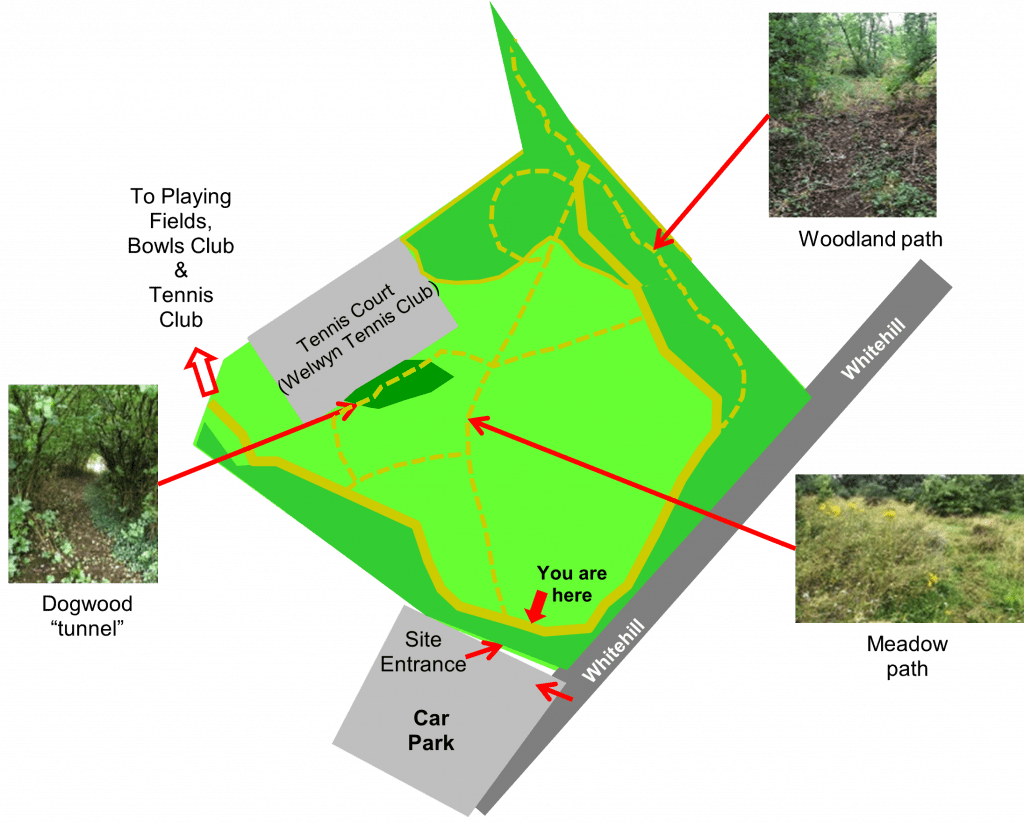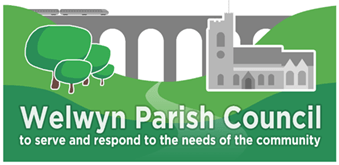Whitehill Wildflower Meadow
The Whitehill Wildflower Meadow is situated adjacent to the Whitehill car park, just off Whitehill, Welwyn. It is owned and maintained by Welwyn Parish Council for the Community, with expert guidance from the Herts and Middlesex Wildlife Trust.
It was registered as a Local Wildlife Site by the Hertfordshire Environmental Records Centre in 2020, reference number 43/072.
What is a wildflower meadow?
It’s an area of permanent grass where wildflowers grow – not a bed of cornfield annuals like poppies, nor the gold-themed flowers which were planted around the Olympic park. The reason it’s important to make the distinction is that poppies grow on disturbed soil. Wildflower meadows grow better on unproductive soil, where vigorous grasses don’t out-compete the wild flowers. Such a meadow is a lively feeding and nesting ground for insects, birds and small animals and the majestic flowers and grasses, bursting with colour, will be an attractive feature. Our countryside was once full of meadows bursting with a diverse variety of colourful flowering plants. Since the 1930s, we have lost over 97% of what is called ‘unimproved grassland’, principally through the imperative to grow food in WW2 – which were not reinstated and those that are left are fragmented. Improved grassland management to obtain greater yields of hay and sileage also has a damaging effect on meadow plants. Run-off of fertiliser from cultivated land can cause wildflower meadows some serious long term harm so we don’t add any nutrients and remove the arisings from strimming to remove nutrients.
Latest News April 2024
Through 2024-2027 we will be working to remove most of the self set Hawthorne trees to help regenerate the meadow areas, this work will be carried out over the winter periods to ensure that nesting birds are not disturbed. We will be continuing work in line with the management plan.
In 2021, Welwyn Parish Council’s Community Engagement Committee has developed a management plan and worked with local volunteers to improve the access to the site, create and maintain pathways, remove a lot of the self-seeded trees and the aggressive grasses to permit the wildflowers to come through and take precedence.
The site, management plan and budget provision are now under the control of the Leisure and Open Spaces Committee. We hope local residents will come and enjoy the facility with their children and discover the beautiful natural world – and continue to walk their dogs!
An information board has been installed to explain the site to visitors, based upon the details given in these web pages. This is of use to all visitors including schoolchildren who we hope will visit as part of their geography or science studies. Over the next few years the council propose to install further information boards and more seating areas.
In 2022 and 2023 a picnic bench and waste bin were installed on the lower area and a single bench was installed halfway up the meadow giving a beautiful place to stop and rest and enjoy the view. Using a grant from the UK Prosperity Fund the entrance ramp was graded and a handrail fitted to make the site much more accessible to our visitors.
Access
Please see the illustrative map of the site below to see how the site may be accessed:
- From the Whitehill Car Park: from Welwyn High Street, drive up School Lane approximately 400 metres; take the first turning on the left (Whitehill) which is a single track road with passing places. The entrance to the car park is 50 metres from the junction, on the left). The car park is free to use with no time restriction. The site entrance is directly from the southern edge of the car park and is indicated with a sign.
- From Ottway Walk Playing Fields: from London Road opposite The Steamer pub, turn into Ottway Walk and either park in the car park by the Sports & Social Club, or drive to the Whitehill Centre car park (both are free to use with no time restriction) or walk up the driveway (it is about 250 metres to the site entrance). Follow the driveway in front of Spindebury Cottage; past the cottage turn left (Whitehill Centre is straight on) heading towards the Tennis Club; just past the Bowls Club on the right, turn right and go along the sloping grass area for about 30 metres; there is an opening in the hedge to your left, which is the start of the path
down the hill (by the hollow red arrow on the map); there is no sign there yet.
Access on the mown perimeter path (the wider contiguous line) is especially suitable for dog walkers. A combined normal rubbish and dog waste bin is situated by the picnic bench near the site entrance. There are other dog waste bins around the Ottway Walk Playing Fields at the top of the hill.
Narrower discrete paths (dashed lines) enable you to enjoy the wildflower meadow (which includes ant hills, scattered Apple trees, and Hawthorns), traditional woodland and the “tunnel” through the Dogwood trees.
All of the paths are mown/strimmed but none are made up with paving, gravel or tarmac and so may be soft in places or uneven. Please wear suitable footwear. They are also located on the slope of a hill so those who have difficulty walking (e.g. those who may need a walking stick or frame for support) or need a wheelchair, should take care. Because this is a site where we want to allow nature to take its own course with minimal interference by man, the ground and going may be unsuitable for wheelchairs, at least in parts. All site users should take care with low or fallen branches, thorny stems and slippery areas. This is an area for walking, observing and enjoyment; you are most welcome to sit and enjoy a picnic, but any games should be exercised on the excellent playing fields at the top of the hill.

History
As with much of Whitehill, and as the name suggest, the underlying geology is chalk. Behind the car park was a chalk quarry in the 19th and early 20th centuries. The diversity of the wild flowers and the ant hills suggest this site was originally a meadow with a small established woodland. There is some evidence to suggest that it has been a cider Apple orchard in past times. In the last 30 years, 12 Apple trees and 4 Horse-chestnut trees have been randomly planted and there are still some Apple varieties growing there. However the site was unmanaged for many years apart from mowing to enable access and as a consequence, used only for recreation. In living memory, the meadow has only been used for dog-walking and by the local Primary School as part of a cross country running route.
After an initial idea from the Parish Council’s Community Engagement Committee to re-invigorate the field, a plant survey was undertaken by the Herts and Middlesex Wildlife Trust in 2020. As a result, later that year the site was designated a Local Wildlife Site and Local Nature Reserve and is registered by The Hertfordshire Environmental Records Centre as Whitehill Meadow under Ref 43/072. Since then, volunteers have removed over 300 Ash and Field Maple seedlings to prevent the site reverting to woodland, with the inevitable loss of the important wildflower meadow. They have also sown Yellow Rattle seeds to help suppress aggressive grasses, planned the route of the narrow pathways, cleared the pathways through the woodland and worked on the site’s management plan (see Management 6H:\Welwyn Parish Council\Whitehill Wildflower Meadow\Management) the placement of a new site entrance directly from the Whitehill car park to replace the older, slippery access slope and the Information Board erected in 2022. The picnic bench was provided by Richard Smith (then our local County Councillor) from his locality budget and the combined litter and dog waste bin was provided by the Parish Council.
Management
This is detailed in the management plan, and includes cutting and clearing twice a year to improve the botanical diversity by removing tall aggressive grasses. We strim in strips, leaving every 4th strip untouched; the arisings are left on the ground for a few weeks to allow the insects and other animals to move to adjacent strips; those uncleared strips are then strimmed in a further 6 months. The main path around the site is mown to given a sound surface that is usable by most people, but strimming is used for the grass areas and smaller paths as this is far better for wildlife conservation and, including the anthills and proliferation of wild flowers. The cutting and clearing of the grass is undertaken by the Parish Council’s contractor. All other work (except for specialist tree surgery when required) is undertaken by volunteers (see Want to get involved ? 8)
For such a small site (0.7 hectare or 1.7 acres) the wildlife is surprisingly diverse:
The Wildflower Meadow: This is a nationally rare wildlife habitat. The upper areas of the site are the most diverse. Work is ongoing to diversify the flora in the lower areas dominated by aggressive grasses by the introduction of yellow rattle and cowslips.
Trees and Shrubs: There are areas of dense impenetrable Bramble and Blackthorn, the latter cloaked in white flowers in
late March and masses of sloes in autumn. The unusual Dogwood woodland, very attractive to insects when in flower
in April/May, can be accessed via a dark, tunnel-like path. The Apples and scattered Hawthorns produce blossom in April/May and abundant fruit for birds such as Redwings in autumn and winter.
Species
All the following photos of wild flowers were taken on this site and the butterfly and bird species have all been seen locally. How many can you spot on the site?





Want to get involved ?
Apart from the mowing and strimming carried out carried out by the contractor there is little regular work required to maintain the site. From time to time there could be a need for some seasonal activities eg, clearing paths, removing seedling trees. If you would be interested in getting involved please register your interest with the Parish Clerk.
Just enquire at the Parish Office, or e-mail the Parish Clerk at office@welwynpc.org.uk or telephone 01438 716667.
Even just by visiting this lovely site, you can help us!
Please help us take care of this valuable and rare site and its contents so future generations may enjoy it:
- Take any litter home with you or deposit it in the litter bins on or near the site
- Clean up after your dog and deposit the waste in the dog waste bins or composite bins provided on or near the site
- Observe and photograph the flowers, insects and other wildlife
- Keep to the paths within the meadow and wood areas
Please do NOT
- Disturb any wildlife or allow your pet to harass it or cause distress
- Dig up any plants (unless authorised)
- Ride mountain bikes or other wheeled vehicles (other than wheelchairs) on the site – not even the paths – unless authorised
- Walk across the adjacent field to the south – it is the property of a local farmer and used for crop growing
- Light fires or barbeques
